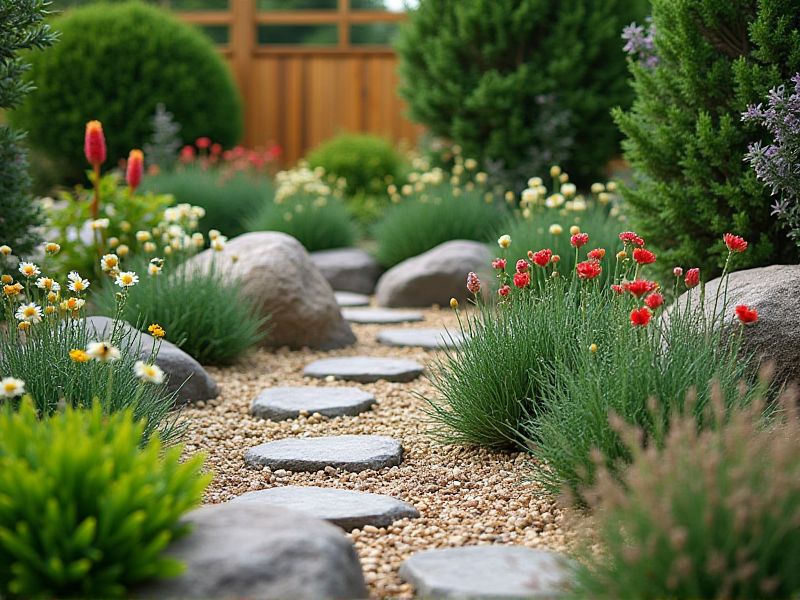
When selecting rock garden plants that thrive in well-draining conditions, consider options like Sedum, Sempervivum, and Alpine Aster. These resilient species are adapted to survive in rocky, dry environments, making them ideal for maximizing drainage. Succulents, such as Echeveria and Agave, also flourish in these settings, with their fleshy leaves storing water and minimizing root rot risks. Incorporating ornamental grasses like Festuca can provide texture while enhancing the drainage capabilities of your rock garden. Prioritizing these plants not only ensures a vibrant landscape but also promotes healthy growth in areas where water retention could be detrimental.
List of some Rock garden plants that require drainage
- Creeping Thyme (Thymus serpyllum)
- Sedum (Sedum spp.)
- Ice Plant (Delosperma spp.)
- Lavender (Lavandula spp.)
- Blue Fescue (Festuca glauca)
- Prickly Pear Cactus (Opuntia spp.)
- Rock Soapwort (Saponaria ocymoides)
- Alpine Aster (Aster alpinus)
- Snow-in-Summer (Cerastium tomentosum)
- Rock Cress (Aubrieta deltoidea)
Important things about Rock garden plants that require drainage
Soil Composition
Rock garden plants thrive in well-drained soil, making soil composition a crucial factor for their success. Incorporating materials like gravel, sand, and perlite can enhance drainage, preventing root rot and promoting healthy growth. Native drought-tolerant plant species, such as sedums and yarrows, flourish in these rocky textures, as they are adapted to low-nutrient, fast-draining environments. Choosing the right mix ensures your rock garden remains vibrant and sustainable, allowing your plants to flourish even in challenging conditions.
Plant Selection
When selecting rock garden plants, prioritize species that thrive in well-drained soil to prevent root rot. Succulents, such as Sedum and Sempervivum, are excellent choices due to their drought-resistant properties and ability to flourish in rocky environments. Additionally, alpine plants like Lewisia and Dianthus are known for their adaptability to harsh conditions and preference for excellent drainage. Ensuring that your rock garden incorporates gravel or sand can further enhance drainage, creating an ideal habitat for these resilient plants.
Drainage Slope
Proper drainage is crucial for the health of rock garden plants, as they thrive in well-drained soil to prevent root rot and other moisture-related issues. When designing your rock garden, ensure that the slope encourages water runoff, directing excess moisture away from plant roots. Popular rock garden plants such as Sedum, Thymus, and Sempervivum typically prefer a drainage-friendly environment, thriving in sandy or gravelly substrates. Enhancing your garden's drainage can also involve incorporating materials like pebbles or crushed stone, which not only improve water flow but also add to the aesthetic appeal of your landscape.
Watering Frequency
Rock garden plants thrive in well-drained soil, making proper watering a crucial aspect of their care. These plants typically require infrequent watering, as excess moisture can lead to root rot and other irrigation-related issues. It is essential to observe the soil's dryness to determine when to water; a general rule is to allow the top inch of soil to dry out before rehydrating. By paying attention to your rock garden's unique microclimate and soil conditions, you can maintain the ideal balance of moisture for healthy growth.
Root Depth Requirements
Rock garden plants thrive in well-drained soils, making root depth an essential consideration for their health. Shallow-rooted species, such as alpine saxifrages and creeping thyme, benefit from a depth of 6 to 12 inches, which allows for adequate drainage while supporting their growth. In contrast, deeper-rooted varieties like sedums may require at least 12 to 18 inches to access water and nutrients without becoming waterlogged. Ensuring proper root depth not only prevents root rot but also promotes stronger and more resilient plants suited for rock garden environments.
Climate Adaptability
Rock garden plants thrive in well-drained soil, making them ideal for climates with varying rainfall and drainage needs. Species such as Sedum, Sempervivum, and Thymus are excellent choices, as they can withstand dry conditions while flourishing in rocky environments. These plants often display unique textures and colors, enhancing the aesthetic appeal of your garden while requiring minimal maintenance. Ensuring proper drainage not only promotes healthy growth but also prevents root rot, allowing your rock garden to flourish across diverse climatic conditions.
Mulching Practices
Rock garden plants, including alpine species and succulents, thrive in well-drained environments, making effective mulching practices essential. Using inorganic materials like gravel or crushed stone enhances drainage while providing a decorative finish that complements the rugged aesthetic of rock gardens. Organic mulches, such as wood chips, can retain moisture but may require careful placement to avoid waterlogging around sensitive plants. Prioritizing a balance between aesthetics and functionality ensures that your rock garden remains vibrant and healthy, supporting the diverse plant life that flourishes in these specialized environments.
Fertilization Needs
Rock garden plants thrive in well-drained soil, essential for preventing root rot and promoting healthy growth. Perennial varieties such as sedums and sempervivums are ideal choices, as they adapt well to the rocky terrain and demand less moisture. For optimal fertility, consider incorporating organic amendments like compost or bone meal to enhance nutrient content without compromising drainage. Regularly monitoring soil moisture levels will ensure your rock garden remains a vibrant, flourishing ecosystem while minimizing water retention.
Pest Management
Rock garden plants thrive in well-drained environments, making proper drainage essential for their health. Species like sedums, alpine asters, and dwarf coneflowers flourish in rocky soils that prevent water accumulation. Poor drainage can lead to root rot and other fungal diseases, jeopardizing your garden's aesthetic appeal. Incorporating gravel or sand into the soil mix can enhance drainage, ensuring your rock garden plants remain vibrant and resilient.
Maintenance Routines
Rock garden plants thrive in well-draining soil, which prevents waterlogging and root rot. To maintain optimal conditions, ensure your garden incorporates materials like gravel, sand, or perlite mixed with soil to enhance drainage. Regularly check for compaction and loosen the soil around the roots to promote airflow. Consider incorporating drought-tolerant species such as sedums and alpine plants that naturally flourish in rocky, well-drained environments.
